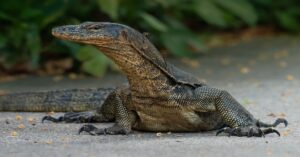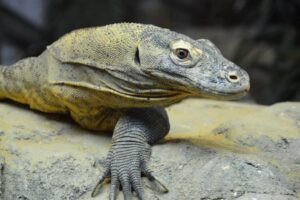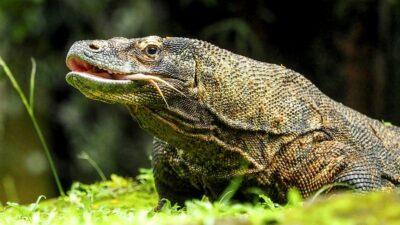Monitor lizards, with their sleek bodies and keen eyes, often evoke a sense of mystery and intrigue. From the sprawling savannas of Africa to the dense forests of Southeast Asia, these reptilian predators have earned a reputation for their cunning and adaptability. But just how smart are monitor lizards?
Monitor lizards are highly intelligent reptiles. They exhibit problem-solving skills, learning abilities, and complex social behaviors. Some species, like the Komodo dragon, have been observed using tools in the wild, which is a sign of advanced cognitive abilities.
In captivity, monitor lizards can also learn to recognize their owners and interact with them in various ways. Overall, while their intelligence might not match that of mammals like dogs or primates, monitor lizards are certainly among the smarter reptiles.
Evaluating the intelligence of monitor lizards

Evaluating the intelligence of monitor lizards involves observing various cognitive abilities and behaviors. Here are some aspects commonly considered:
- Problem-solving skills: Monitor lizards demonstrate the ability to solve simple problems in their environment, such as finding food or accessing shelter. They may use trial and error or employ strategies based on past experiences.
- Learning ability: Monitor lizards can learn through observation and experience. They can recognize patterns, remember locations of resources, and adapt their behavior accordingly.
- Tool use: Some species of monitor lizards have been observed using objects in their environment as tools. For example, they may use sticks to probe into crevices in search of prey.
- Social behavior: Monitor lizards exhibit complex social interactions, particularly during mating and territorial disputes. They can recognize individuals within their social group and adjust their behavior accordingly.
- Communication: While not as vocal as mammals, monitor lizards communicate through body language, visual displays, and chemical signals. They can convey information about their intentions, mood, and social status.
- Memory: Monitor lizards have been shown to possess good spatial memory, remembering the locations of resources and potential threats in their environment.
- Problem-solving experiments: Controlled experiments can be conducted to assess monitor lizards’ ability to solve specific tasks, such as navigating mazes or manipulating objects to obtain rewards.
Overall, while monitor lizards may not exhibit the same level of intelligence as mammals like primates or dolphins, they display a range of cognitive abilities that highlight their adaptation to their environment and ecological niche.
How smart are monitor lizards?
Assessing the intelligence of monitor lizards involves considering various cognitive abilities and behaviors they exhibit. While they may not display the same level of intelligence as mammals or birds, monitor lizards demonstrate remarkable cognitive skills that are well-suited to their ecological niche. Here’s a detailed explanation of their intelligence:
- Problem-solving skills: Monitor lizards exhibit problem-solving abilities when faced with challenges in their environment. For example, they can navigate complex terrain to find food, water, or shelter. In captivity, they may learn to navigate mazes or manipulate objects to access rewards, indicating their ability to solve novel problems.
- Learning and memory: Monitor lizards are capable of learning from experience and remembering important information. They can recognize familiar individuals, remember feeding locations, and adjust their behavior based on past experiences. This ability to retain information helps them adapt to changing conditions and make informed decisions.
- Social cognition: While not as social as some other animals, monitor lizards display social behaviors such as territorial defense, courtship rituals, and hierarchical interactions. They can recognize conspecifics, communicate using visual signals and body language, and adjust their behavior based on social cues.
- Tool use and manipulation: Some species of monitor lizards have been observed using objects in their environment as tools to aid in hunting or foraging. For example, they may use sticks or rocks to dislodge prey from hiding places or to construct burrows. This demonstrates their ability to innovate and adapt their behavior to solve specific problems.
- Communication: Monitor lizards communicate through a variety of visual, olfactory, and tactile signals. They may use body posture, coloration, tail movements, and scent markings to convey information about their intentions, territory boundaries, and reproductive status. This ability to communicate helps them coordinate social interactions and avoid conflicts.
- Cognitive flexibility: Monitor lizards demonstrate cognitive flexibility, allowing them to adjust their behavior in response to changing environmental conditions or new challenges. They can switch between different foraging strategies, adapt to changes in prey availability, and learn from trial-and-error experiences.
- Complex behaviors: Monitor lizards engage in a range of complex behaviors that require cognitive skills, such as hunting, mating rituals, and territorial defense. These behaviors involve decision-making, planning, and coordination of movements, indicating a level of intelligence beyond simple instinctual responses.
Overall, while monitor lizards may not possess the same level of intelligence as mammals or birds, they exhibit a range of cognitive abilities that enable them to thrive in diverse environments. Their intelligence is shaped by evolutionary adaptations to their ecological niche, allowing them to effectively navigate and interact with their surroundings.
Comparative analysis with other reptiles and vertebrates

When comparing the intelligence of monitor lizards with other reptiles and vertebrates, several factors come into play. Here’s a comparative analysis:
- Mammals: Generally, mammals are considered to be the most intelligent group of animals. They often exhibit complex social structures, problem-solving abilities, and advanced forms of communication. Species like primates, dolphins, and elephants are particularly known for their high intelligence.
- Birds: Birds, especially corvids (such as crows and ravens) and parrots, are renowned for their cognitive abilities. They can solve puzzles, use tools, and exhibit remarkable feats of memory and learning. Some bird species rival or even surpass certain mammals in intelligence tests.
- Monitor Lizards (Reptiles): Among reptiles, monitor lizards are considered some of the most intelligent. They demonstrate problem-solving skills, social behaviors, and learning abilities. While they may not match the cognitive complexity of mammals and some bird species, they are still highly adaptable and capable predators.
- Other Reptiles: Compared to other reptiles, such as snakes and turtles, monitor lizards generally exhibit higher levels of intelligence. While all reptiles have basic cognitive functions, monitor lizards stand out for their ability to navigate complex environments, learn from experience, and engage in social interactions.
- Fish and Amphibians: Fish and amphibians typically have simpler nervous systems compared to mammals, birds, and reptiles. While some species demonstrate learning abilities and problem-solving skills, they generally do not exhibit the same level of cognitive complexity as other vertebrates.
- Invertebrates: Invertebrates, such as insects and cephalopods (like octopuses), also display remarkable cognitive abilities. They can solve puzzles, exhibit learning behaviors, and even display forms of social interaction. Some studies suggest that certain invertebrates might possess higher cognitive abilities than previously thought.
Overall, while monitor lizards rank high among reptiles in terms of intelligence, they may not reach the same levels as mammals and some bird species. However, their cognitive abilities are still impressive and allow them to thrive in diverse environments.
Cognitive Abilities in Monitor Lizards
Cognitive abilities in monitor lizards encompass a range of mental processes and behaviors that enable them to interact with their environment, solve problems, and adapt to various challenges. Here are some key cognitive abilities observed in monitor lizards:
- Spatial cognition: Monitor lizards possess a keen sense of spatial awareness, allowing them to navigate through complex environments efficiently. They can remember the locations of resources such as food, water, and shelter, and use landmarks to orient themselves.
- Problem-solving: Monitor lizards exhibit problem-solving skills when faced with challenges such as obtaining food, escaping predators, or accessing shelter. They may employ trial-and-error strategies, learn from past experiences, and demonstrate flexibility in finding solutions.
- Learning and memory: Monitor lizards are capable of learning from experience and remembering important information. They can recognize familiar individuals, remember feeding locations, and recall successful hunting techniques. This ability to retain information helps them adapt to changing conditions in their habitat.
- Social cognition: While not as social as some other vertebrates, monitor lizards display social behaviors such as territorial defense, courtship rituals, and hierarchical interactions. They can recognize conspecifics, communicate using visual signals and body language, and adjust their behavior based on social cues.
- Tool use and manipulation: Some species of monitor lizards have been observed using objects in their environment as tools to aid in hunting or foraging. For example, they may use rocks or sticks to dislodge prey from hiding places or to construct burrows.
- Communication: Monitor lizards communicate through a variety of visual, olfactory, and tactile signals. They may use body posture, coloration, tail movements, and scent markings to convey information about their intentions, territory boundaries, and reproductive status.
- Problem-solving experiments: Controlled experiments have demonstrated monitor lizards’ ability to solve specific tasks in laboratory settings. For example, they can learn to associate certain cues with food rewards, navigate through simple mazes, or manipulate objects to access hidden treats.
Overall, monitor lizards exhibit a range of cognitive abilities that contribute to their survival and success in diverse habitats. While their intelligence may not match that of mammals or birds, they display remarkable adaptability and behavioral flexibility in response to environmental challenges.
Hunting strategies and foraging behavior

Monitor lizards employ various hunting strategies and foraging behaviors depending on their species, habitat, and available prey. Here are some common hunting strategies and foraging behaviors observed in monitor lizards:
- Ambush Predation: Some monitor lizards, such as the Nile monitor (Varanus niloticus), utilize ambush predation. They remain motionless near water bodies or along trails, waiting for unsuspecting prey to pass by. Once prey is within striking distance, they launch a rapid attack, using their powerful jaws and sharp teeth to capture and subdue the prey.
- Active Hunting: Other monitor lizard species, like the Komodo dragon (Varanus komodoensis), engage in active hunting. They actively search for prey across their territory, using their keen sense of smell and excellent vision to detect potential targets. When prey is located, they pursue it relentlessly, relying on their speed, agility, and strength to catch and overpower it.
- Scavenging: Monitor lizards are opportunistic feeders and will scavenge carrion when the opportunity arises. They may follow the scent of decaying flesh or investigate areas where other predators have made kills. Scavenging allows monitor lizards to obtain food with minimal energy expenditure, supplementing their diet when hunting opportunities are scarce.
- Foraging: In addition to hunting live prey, monitor lizards also forage for a variety of food items, including insects, small vertebrates, eggs, fruits, and carrion. They may use their claws and powerful jaws to dig in soil or leaf litter, overturn rocks and logs, and search within crevices and burrows to locate hidden prey.
- Tool Use: Some monitor lizard species have been observed using tools to aid in hunting or foraging. For example, they may use sticks or rocks to dislodge prey from hiding places or to crack open hard-shelled food items like eggs or mollusks. Tool use demonstrates their problem-solving abilities and resourcefulness in obtaining food.
- Group Hunting (in some species): Certain monitor lizard species, such as the lace monitor (Varanus varius), have been observed hunting cooperatively in groups. They may coordinate their efforts to flush out prey from hiding places or to overpower larger prey items. Group hunting allows them to tackle larger or more challenging prey that they might not be able to subdue individually.
Overall, monitor lizards are versatile hunters and foragers, capable of employing a range of strategies to secure food and survive in diverse environments. Their hunting techniques and foraging behaviors are shaped by their ecological niche, prey availability, and evolutionary adaptations.
Conclusion
Monitor lizards demonstrate impressive cognitive abilities and adaptive behaviors, showcasing their intelligence in various aspects of survival and interaction with their environment. How smart are monitor lizards? They exhibit a level of intelligence that allows them to thrive in diverse ecosystems, making them fascinating subjects for further study and admiration.

